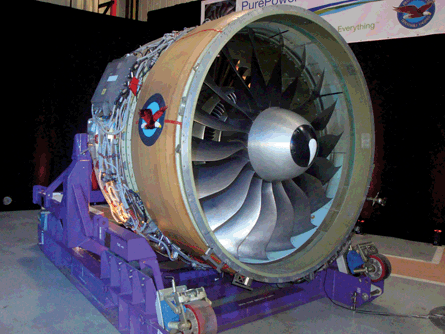Pratt & Whitney has started working on a new family of engines for the military aircraft market based on a gear-less version of the PW1000G series now under development for airliners.
The company has begun a "limited development activity" to adapt the smallest version of the PW1000G - the 15,000lb-thrust (67kN) PW1215 - for military applications, says Jimmy Reed, P&W's director of advanced engine programmes.
At that size, P&W could offer the rebranded PW9000 for the US Air Force's emerging MQ-X unmanned air system requirement, or perhaps to re-engine its Northrop Grumman RQ-4 Global Hawks, Reed says.
Northrop officials note, however, that they are not aware of any plans to replace the RQ-4's Rolls-Royce AE3007 engine.
The same engine technologies could be scaled up to power the next generation of military airlifters, Reed says.
 |
|---|
© Pratt & WhitneyPratt & Whitney has begun a "limited development activity" to adapt the smallest version of its PW1000G for military applications |
Alternatively, a 30,000lb-thrust PW9000 could be adapted for the fighter market, with a re-engining for the F100-series powering Boeing F-15s and Lockheed Martin F-16s possibly under consideration. The new engine could provide 18% better fuel economy than the latest F100 product, Reed says.
The disclosure of the PW9000 offers a glimpse of P&W's future strategy for the military market.
Despite largely dominating military engine technology, the company's prospects appeared to dim in 2007. The Air Force Research Laboratory awarded contracts to start developing the military's next-generation jet engines to General Electric and Rolls-Royce, rejecting two separate bids by P&W.
GE and R-R are both working to develop the so-called Ad-Heete engine, which combine a variable cycle core with an ultra-high pressure ratio combustor, producing an engine vastly more efficient at both subsonic and supersonic speeds.
Meanwhile, P&W has worked to introduce the geared turbofan for the commercial market. In addition to the gear, the PW1000G series includes an all-new, more efficient core. So far, three new aircraft development programmes - the Bombardier CSeries, Irkut MS-21 and Mitsubishi MRJ regional jet - have the geared turbofan selected.
The company has also adapted the PW1000G engine core for business jets with the gear-less PW800. However, the PW9000 will be different from the PW800.
The military engine family will include a smaller fan diameter and more fan stages to increase the pressure ratio, improving acceleration performance at the expense of fuel economy.
Source: Flight International



















